Brushing and tree-trimming
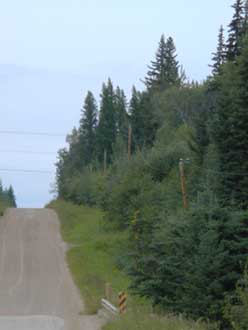
Trees are a blessing. They are
beautiful; but when they grow into
power lines they not only become a nuisance,
they develop into an expensive and dangerous problem.
Brushing and tree trimming need to be done every three
years in the area covered by the Bruderheim REA.
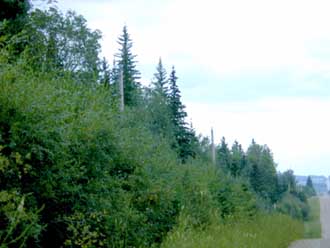 It is
hoped that by doing that the problems caused by trees that touch power
lines can be avoided. However, that doesn't always work that well. It is
hoped that by doing that the problems caused by trees that touch power
lines can be avoided. However, that doesn't always work that well.
This year we must do brushing in our area. A contractor does that
for FortisAlberta. Fortis will then bill the Bruderheim REA for the
brushing that will be done. The work is being supervised by Fortis,
but the directors of the Bruderheim REA also keep an eye on things.
As of now we don't have a clear idea of how much money we will have to
spend on that this year, but we expect that the bill for the brushing
under the power lines will be in the order of $45,000 to $50,000 – it
usually is in that range. That means a cost of $100 to $110 that
needs to be recovered from each member of the Bruderheim REA. Last
year it looked as if we would be spared a big brushing bill this year, but
the crops are not the only thing that grew well this year; trees did too.
The trees
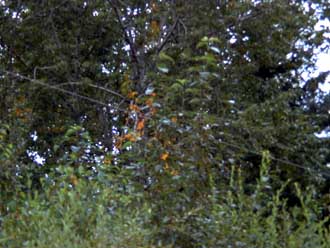 growing
into the power line shown above were trimmed back three years ago, but now
many already touch the power line, and, if left alone, next year many more
would grow into the power line, just as some trees on that piece of power
line already do. growing
into the power line shown above were trimmed back three years ago, but now
many already touch the power line, and, if left alone, next year many more
would grow into the power line, just as some trees on that piece of power
line already do.
How much a tree grows in a given year depends on the weather. It
also depends on the species of tree that is doing the growing. For
example, spruce trees grow an average of about one foot per year, and
black poplar can grow by as much as three feet or more in a given year.
A number of concerns arise when trees grow into power lines. First of
all, there is the safety issue. People have been killed by touching
or pruning trees that in turn touched power lines, especially when the
power lines touched by the trees are on the high-voltage side of a
transformer that serves a property.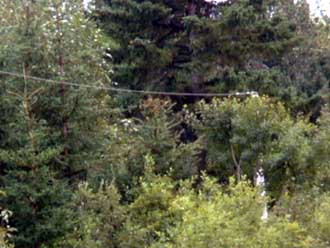
In the picture on the right it can be seen that an aspen growing right
next to a power pole along the road is being trimmed by a power line; its
top branched are being burned off.
Some may think that is a good solution, that it saves work. The
problem is that it is not safe and that it makes for substandard quality
of service.
Not only people but even more likely
cattle can be killed by rubbing against that tree, and there are many
other trees along this stretch of line that are just as close. That
means that if there is ever a load of frost or frozen rain on that line,
the power line can no longer burn off all of the branches touching it.
It will then sag a good amount and touch all of those trees at once.
At the very least a switch will trip because the line becomes shorted out
against ground. At best, the voltage on that line becomes very
noisy, and all the people served by that line will have serious problems
with TV and radio reception because of the noisy line voltage serving
their homes.
It is quite possible that sensitive
electronic equipment served by a noisy and insecure power line will become
damaged when the circuit breaker protecting such a line pops. A
circuit breaker will re-set itself
if the current-flow on that line increases for only a very short interval.
However, if the excessive current-flow exceeds the specified time limit,
the circuit breaker will trip and stay off, making it necessary that a line man
comes out to investigate and to eliminate the source of the problem
causing the service interruption. At times it will be necessary to
do brushing on that portion of the line. The work required for that
is a cost over and above the cost of the regular brushing program cycle.
There is another problem when trees touch power lines.
Energy gets lost. It is known how much energy is being delivered
into the distribution system of an REA. It is also known how much
energy is being used, collectively, by all consumers of electric energy in
an REA. There is always more energy being delivered into the
distribution system than the consumers served by the distribution system
use. The net-difference between what is being delivered and what is
being metered as consumption is called unidentified energy. It is
unidentified because it is not being measured where it is being lost.
It is lost through electrical resistance in transmission- and distribution
lines. At times some of it is being
lost because it is being stolen, but a large portion of that unidentified
energy is being lost by flowing through circuits we don't want, circuits
that are being established through trees that are touching power lines.
By the way, unidentified (un-metered) energy is also being used up
legally and through deliberate design, through pumps on oil wells and
through street lights. The electric energy for pumps on oil wells is
being estimated and billed to the oil company operating a given well.
Of course, those bills are just estimates, and the difference between
estimated and actual power consumption is being added on to the power
bills for all metered services in Alberta. The power used by street
lights is not being metered. It is being estimated, too. That
power is being added on to and distributed over all of the bills for
metered electrical services. Yes, that means that people being
served by rural services, even those that never see the light of a street
light, pay for the energy all of the street lights in use in Alberta.
The producers of electric energy get paid for all of the energy they
deliver into the transmission system. They get paid even for the
energy that is not flowing through the meters installed at the service
ends. The cost of energy that is lost in transmission- and
distribution lines is being paid for, and the cost of that unidentified
energy has traditionally been 3.5 percent of the energy consumption cost
on our bills. Moves are under way to increase the allowance for
unidentified energy to close to seven percent of end consumption that is
metered.
If a lot of trees are touching the power lines in the distribution
system of an REA, that will give the utility corporations more ammunition
in their applications for rate increases that are to cover a doubling of
the allowance for the recovery of the costs of unidentified energy.
All rural consumers suffer in many different ways, increased energy costs
being a major portion of that, when trees are touching power lines.
It would be nice if trees
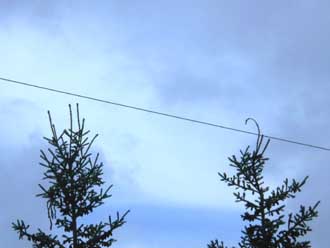 could be
trained to grow around power lines, as the spruce on right side of the
picture on the left is trying to do, but it will be no more successful
doing that than its neighbour to the left. could be
trained to grow around power lines, as the spruce on right side of the
picture on the left is trying to do, but it will be no more successful
doing that than its neighbour to the left.
The farmer that owns the land on which the right-of-way for the power
line illustrated here is located doesn't want the brushing contractor to
clear the right-of-way. He wants the contractor to use the bucket
from the road to trim the trees under the line running along the edge of
his property. The result of that is that every one else on the same
circuit periodically gets an ear-full of noise when listening to the radio
(or a lot of snowy bands running across their TV screens). At times
they will lose their power completely and will have to wait until Fortis
manages to send a service man out to put the tripped switch back into the
on-position. Maybe that is all it will take, but for everyone along
that line that operates sensitive electronic equipment, be prepared for
power hits and outages. They should buy surge protectors for all of
their electronic equipment, and, if operating any kind of computer, buy
an non-interruptible power supply for it. Such a power supply can be
had for about $200 to $300 and will provide them with about five minutes
of time after the power goes off; during which time they may be able to
manage to shut their computer down in the normal manner instead of having
its programs and files corrupted when the power is lost.
Sometimes a tree falls onto a power line, or perhaps it may be even just a branch that
broke off and got stuck that shorts out the power supply if there is also a neutral wire; and that little
branch is often hard to see, especially at night. Power outages are
never nice to experience; needlessly frequent ones are a truly expensive
frustration.
Power-outage
reporting
If the electric power goes off at
your farm, never assume that the power company will
know about it, or that someone else will call the power company to
have service restored.
There is no remote sensing of your service quality. The power
company will not know that your service got interrupted, unless
someone calls them about it. If they get called, they will
send someone out to look into the problem, and usually things are
back to normal in a short time. However, if nobody calls them,
your house plants may freeze, or, worse, the fans in your barns may
be out of service long enough to cause your chickens or hogs to die.
If nothing else, in winter time your cattle waterers may freeze up,
leaving you with thirsty cattle and a fair bit of work to do to make
the waterers operate again. To avoid having any of those
things happening, always call the power
company at 310-9473 (toll-free) when you have an
unforeseen outage.
It has happened that with some outages no-one in an affected
neighbourhood called until things became very uncomfortable in their
houses. By the time someone can come out after that to restore
service, some farms may experience serious problems on account of an
outage. The power company doesn't mind to receive calls from
many service owners when their power goes off; that permits the
power company to assess the extent of the problem that needs to be
fixed.
Check
the power company's views on reporting outages. |
There is the cost of that "repair" job, a job that may be nothing more than
to get rid of that fallen tree or of the hard-to-find branch. All of
the members of the Bruderheim REA pay for those jobs, and all of the
members pay for the three-year cycle of never-ending tree trimming,
because the man that owns the land on which the right-of-way is located
doesn't wish to have a "road along the inside of his fence". Yet, if
the trees were to be cleared right down to the ground, with relatively
cheap spraying every three years as well, the line put in danger by so
many trees growing into it would perform to everyone's greater satisfaction and
would cost everyone a lot less in terms of money and aggravation.
Similar issues come into the picture where a tap off the main line
leads to the transformer in a farm yard. There it is often an even more
hotly contended issue, as people often strongly wish to have the trees
left alone that cause power problems in their own yards and for their neighbours. That cannot be done, neither practically nor legally,
but there are ways to isolate a tap, so that when it fails, only that tap
will be affected, although even that solution will do little to cure
line-noise problems. That is being discussed on the next page. |



